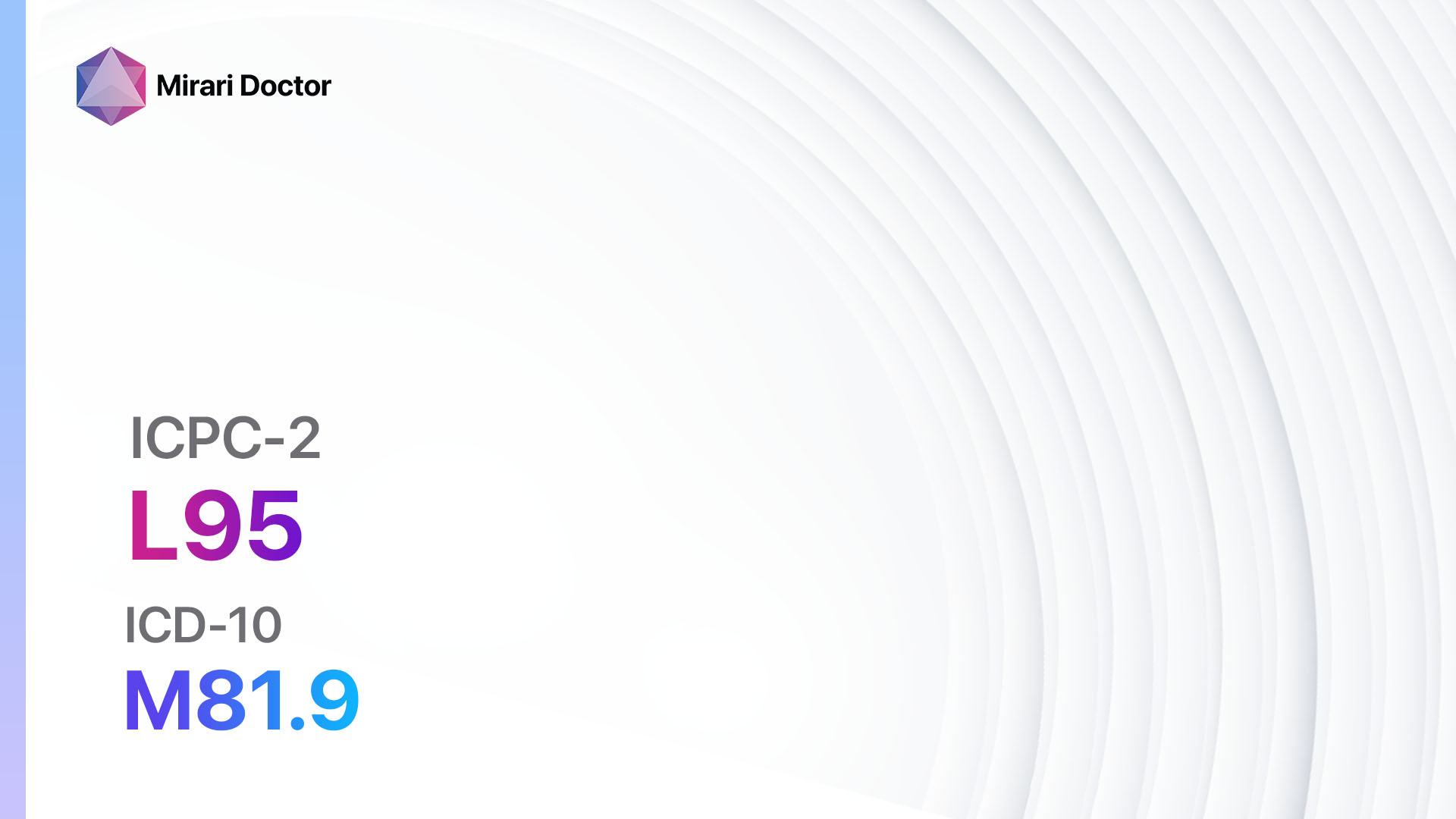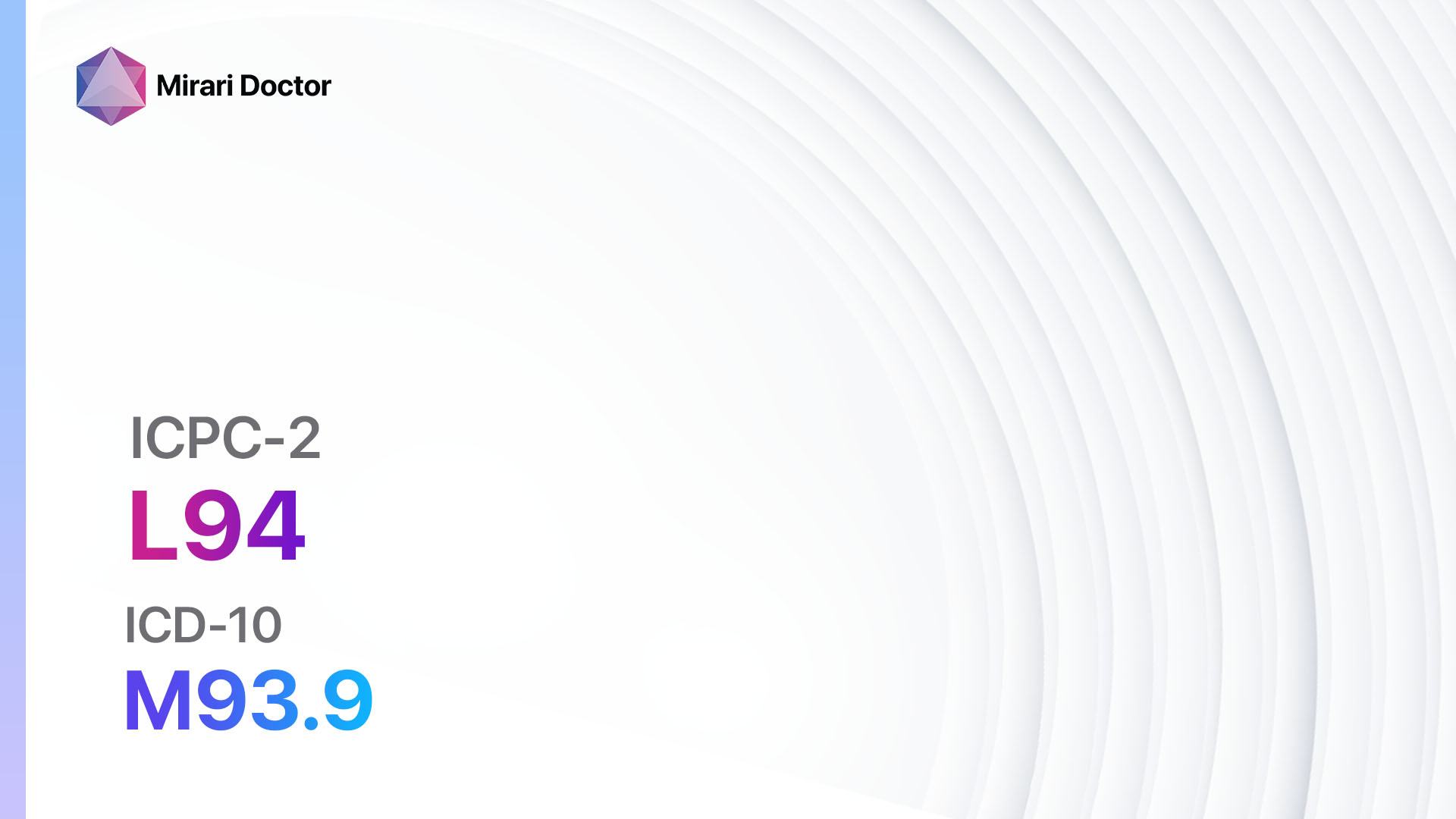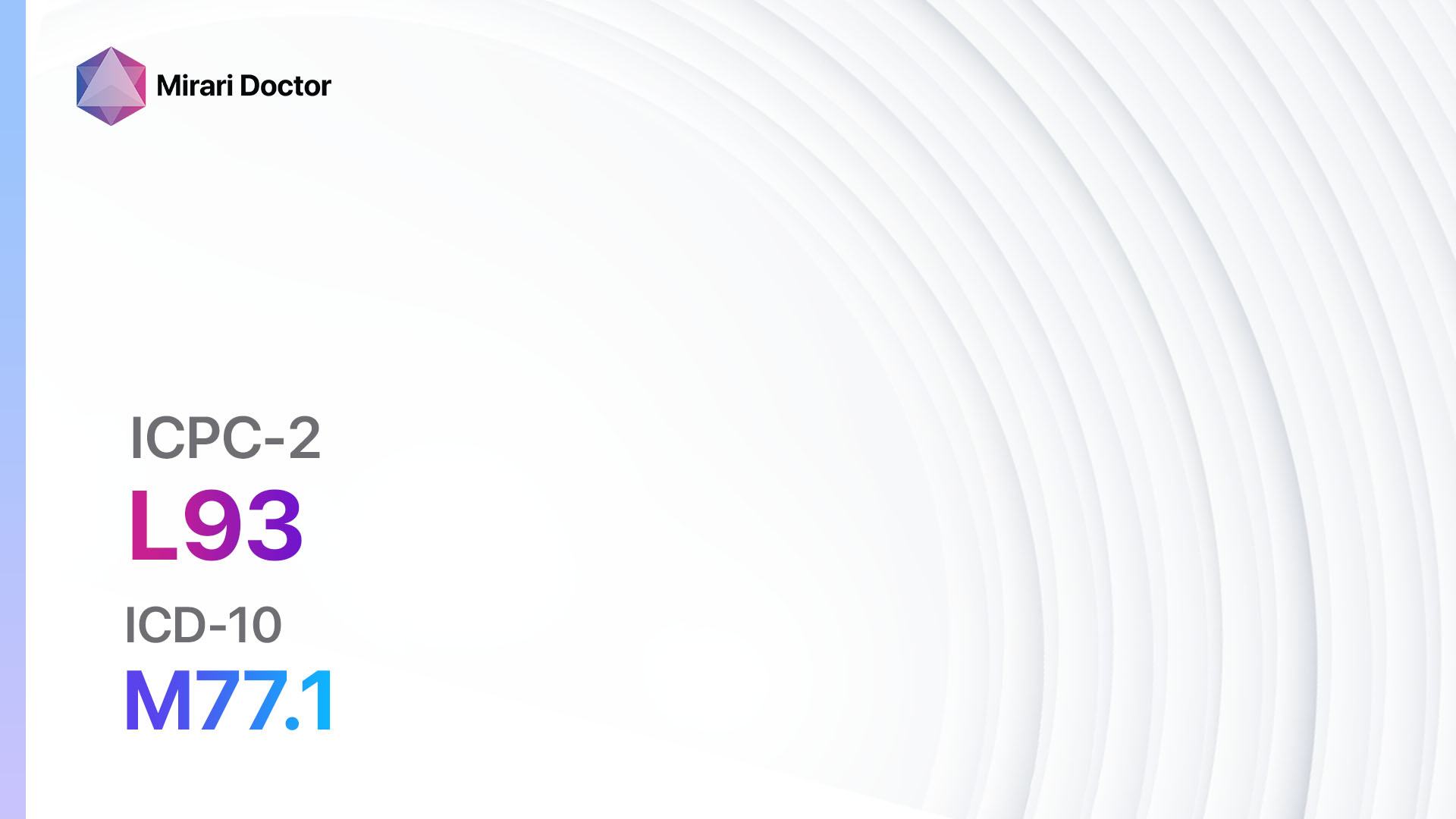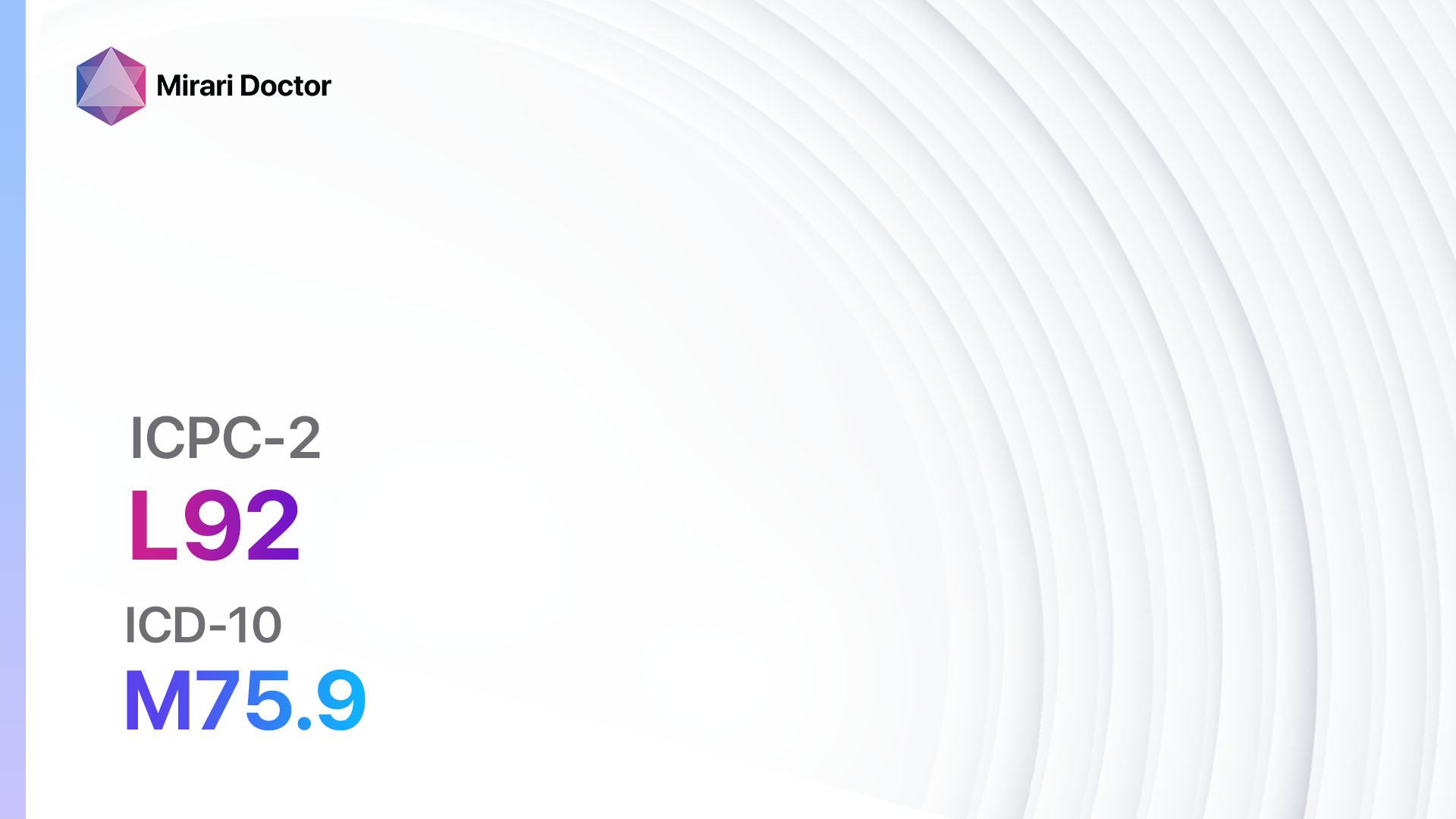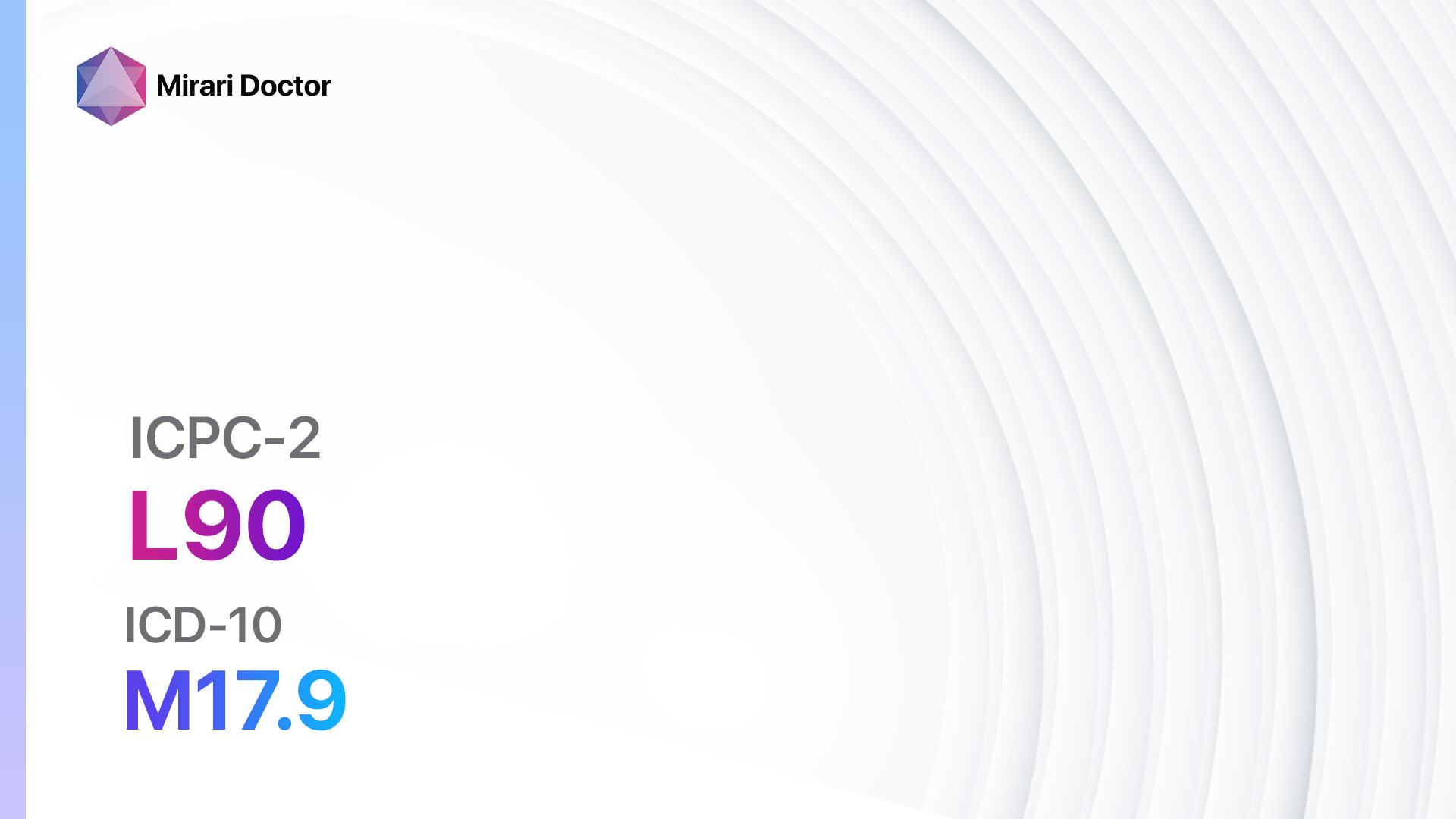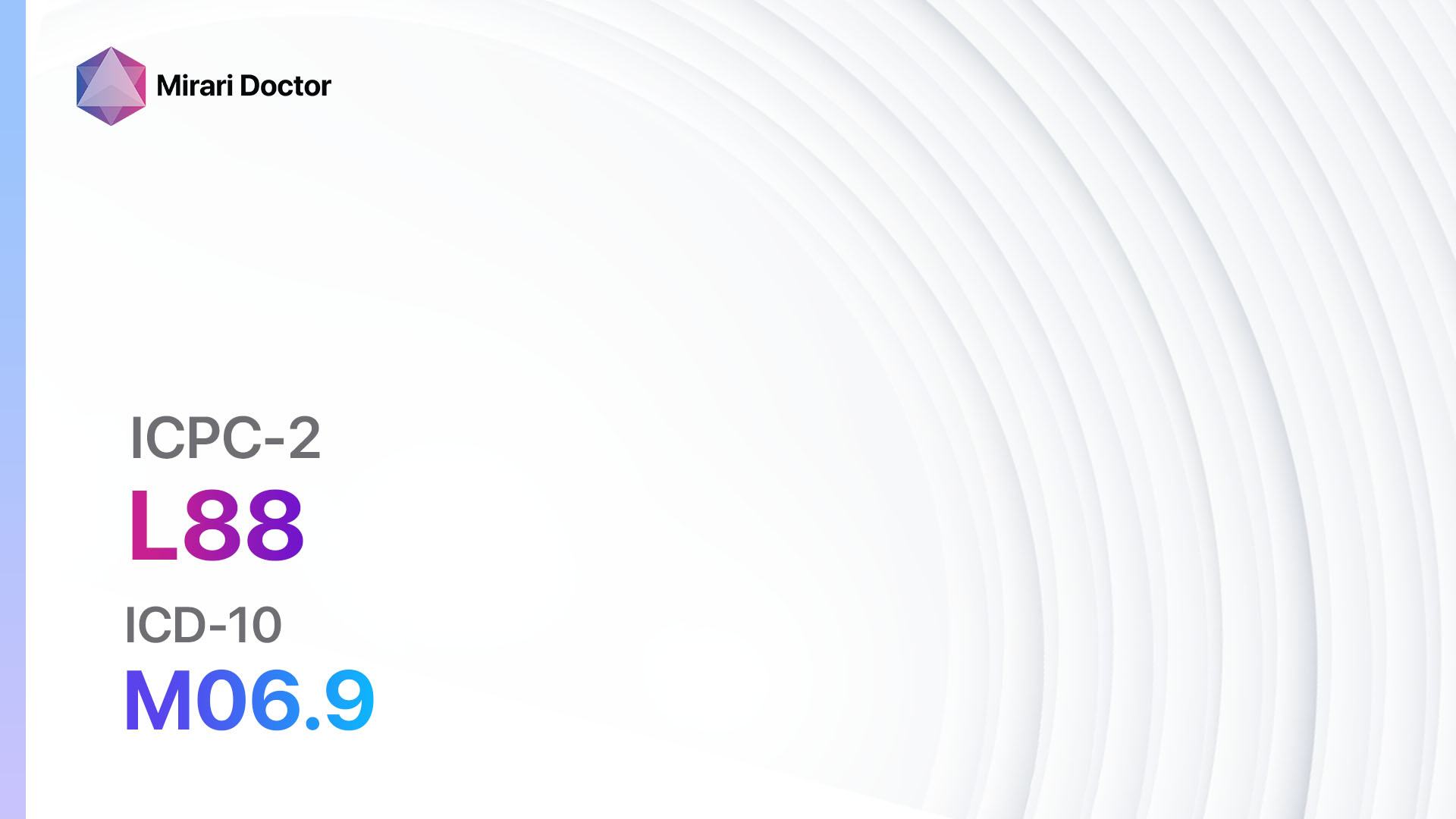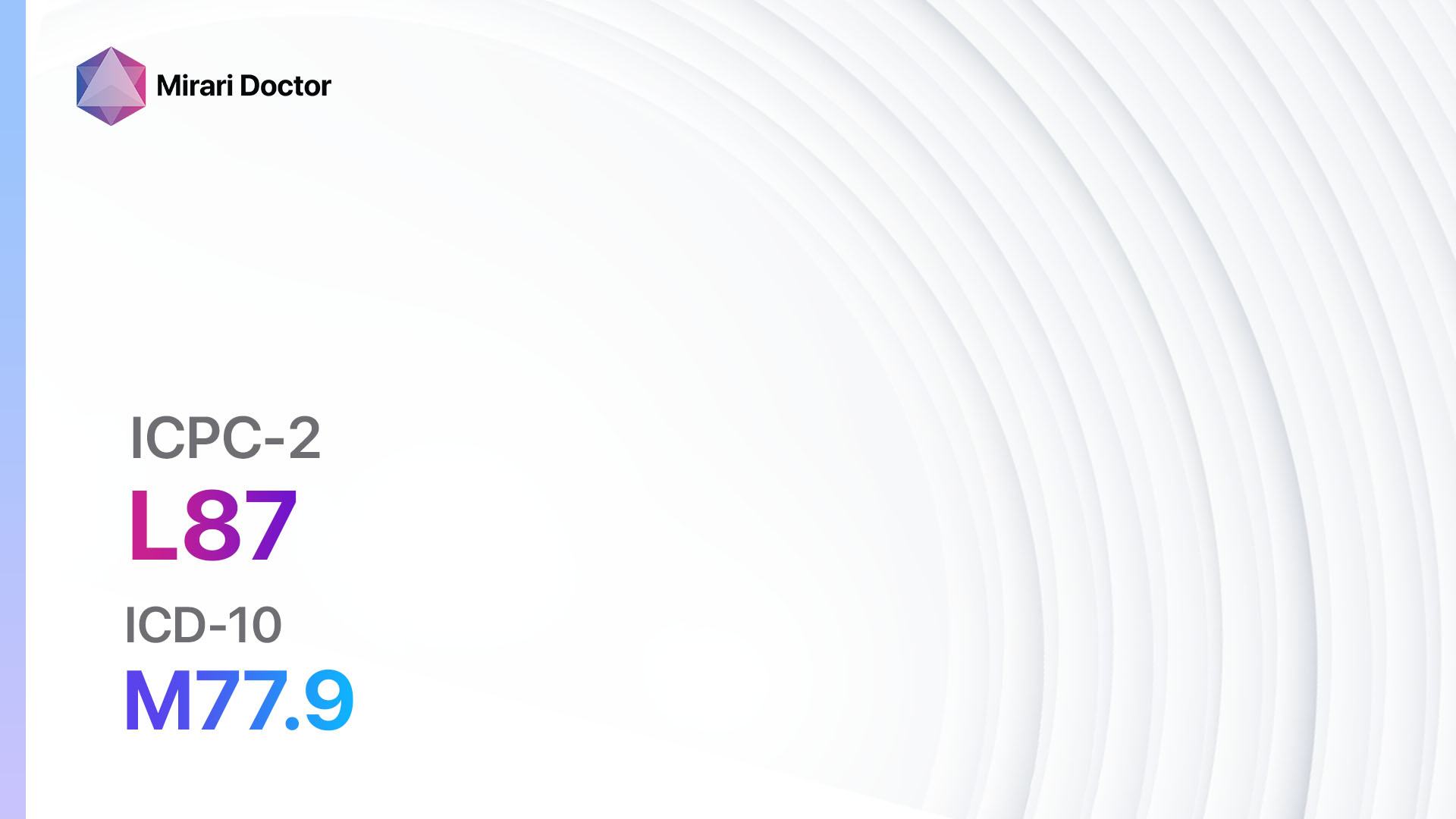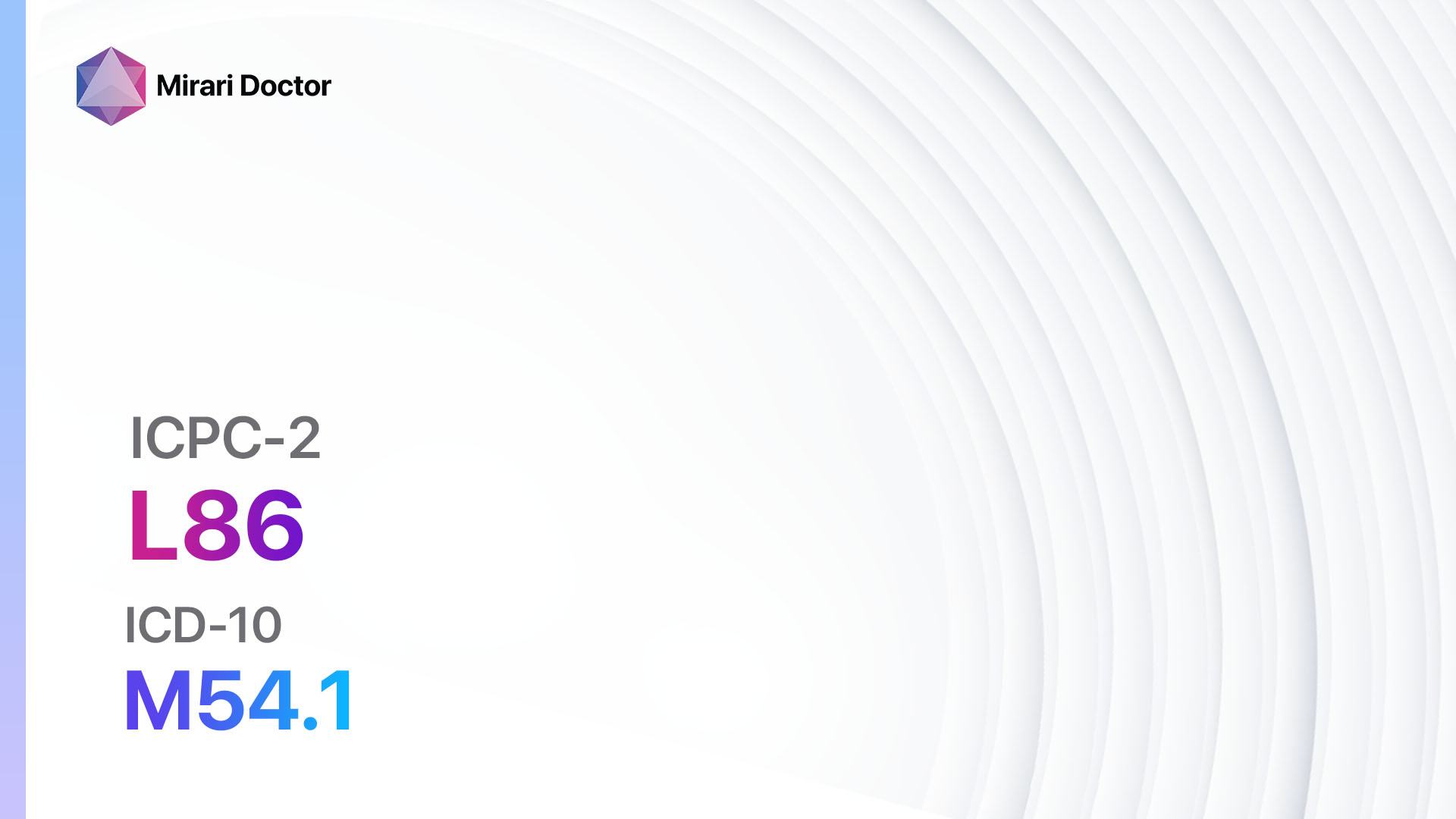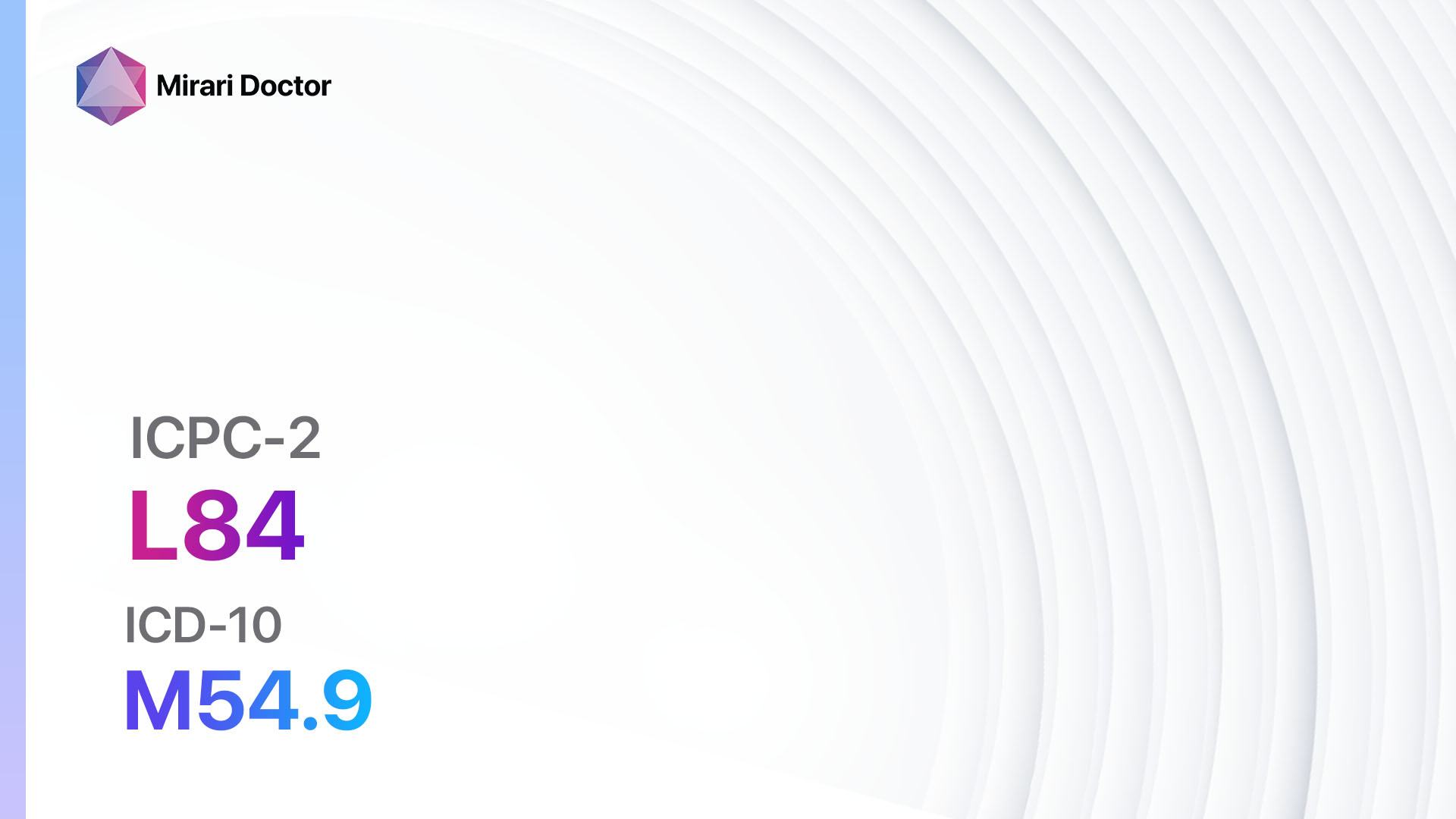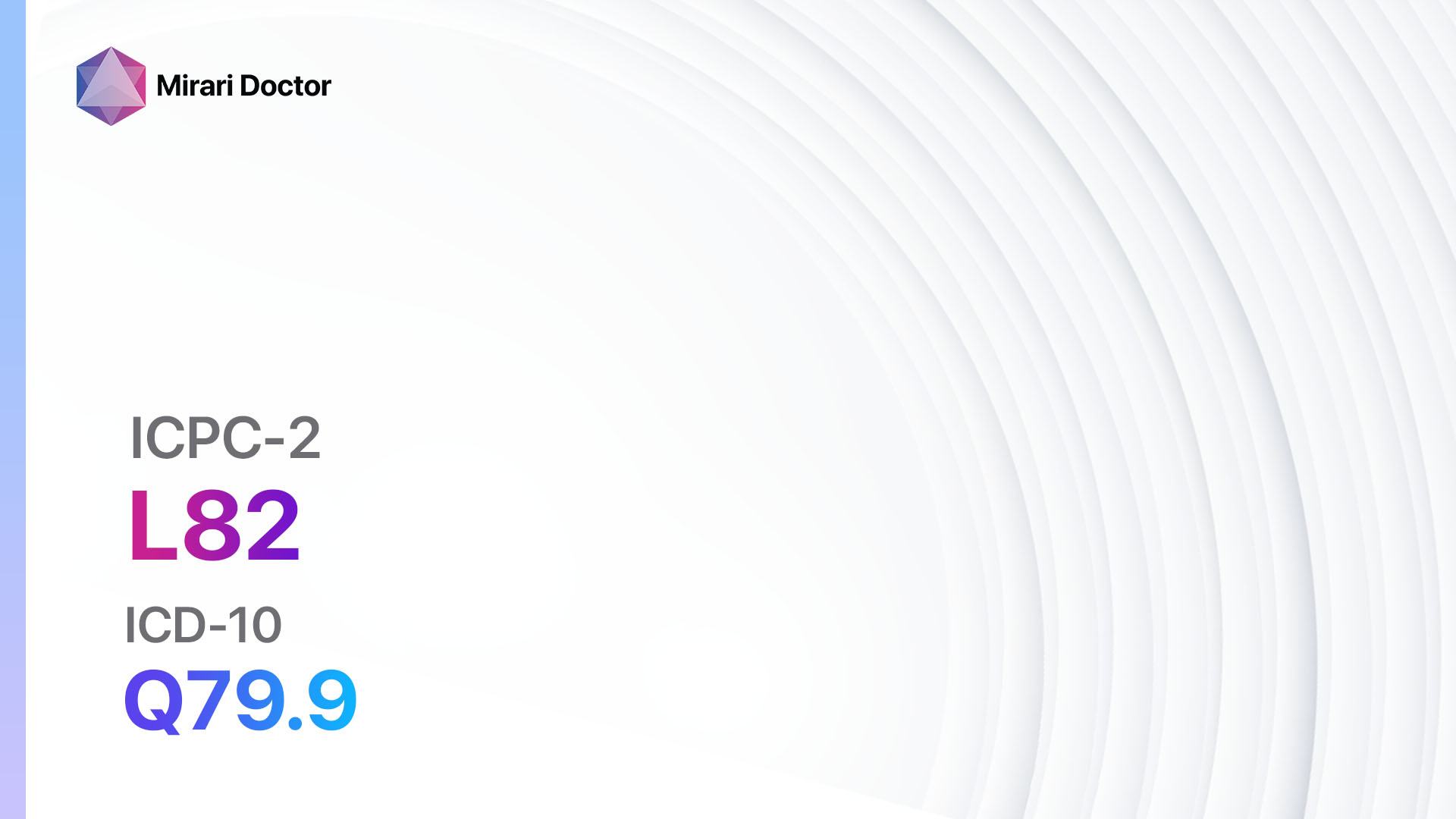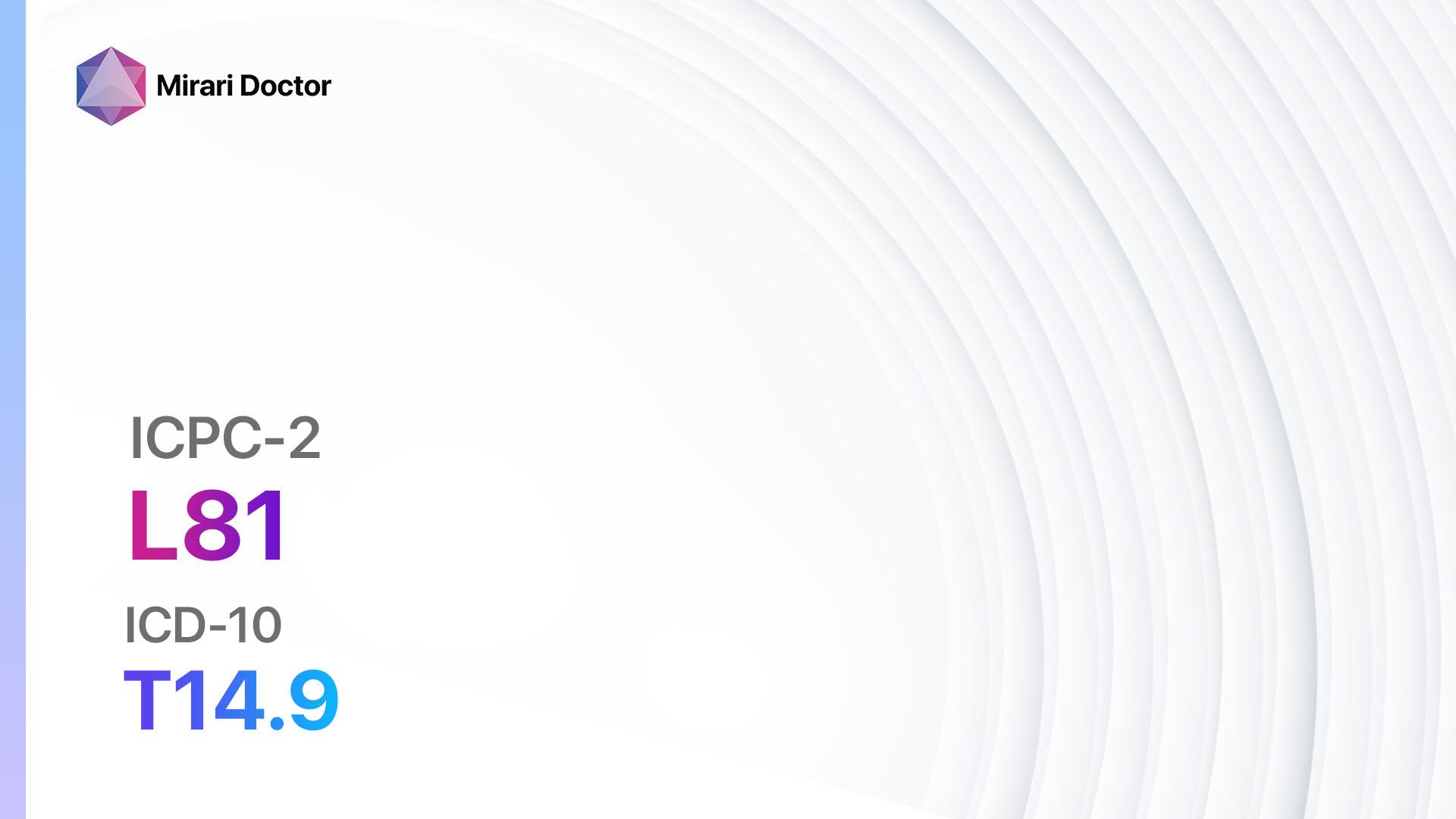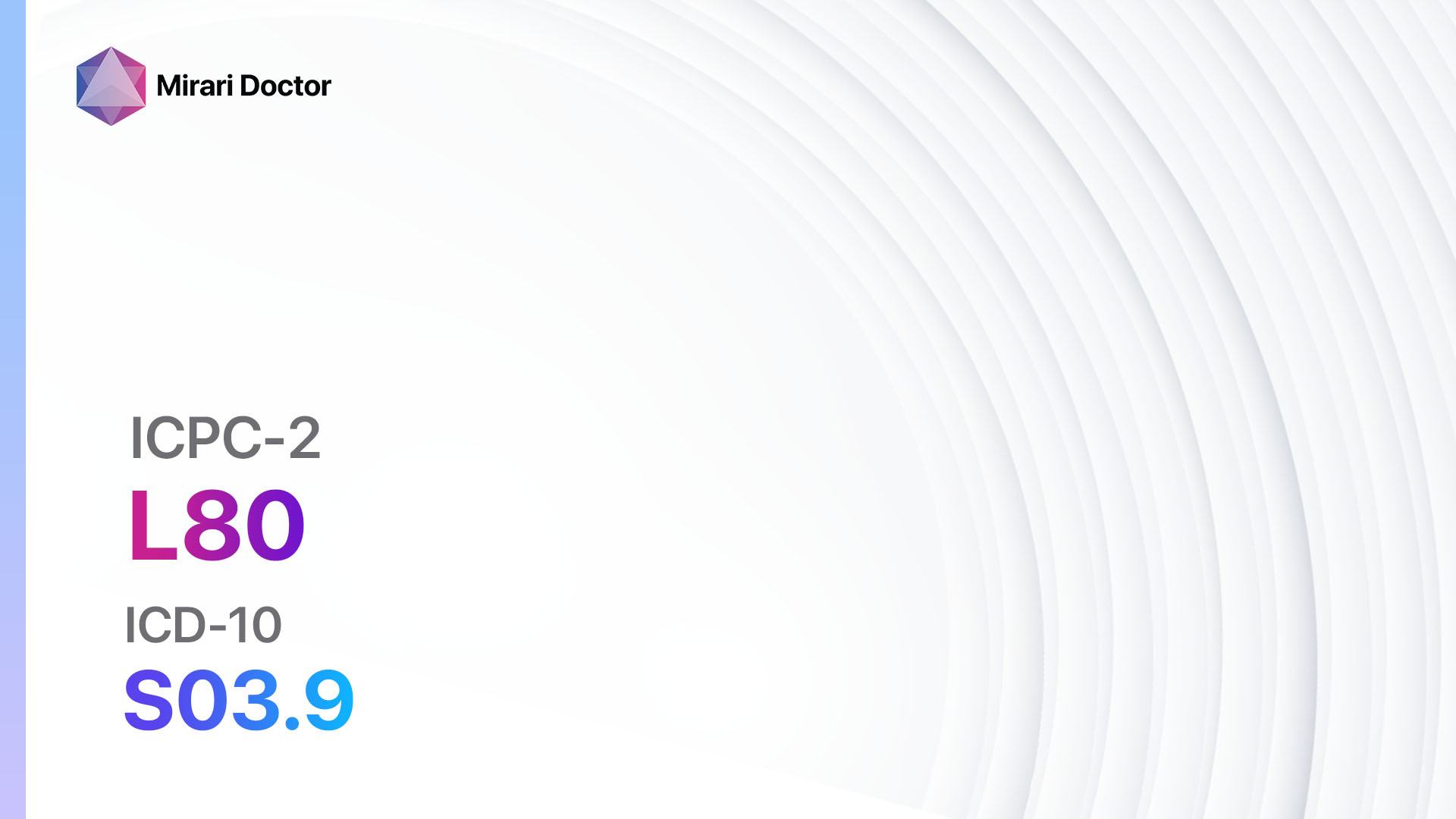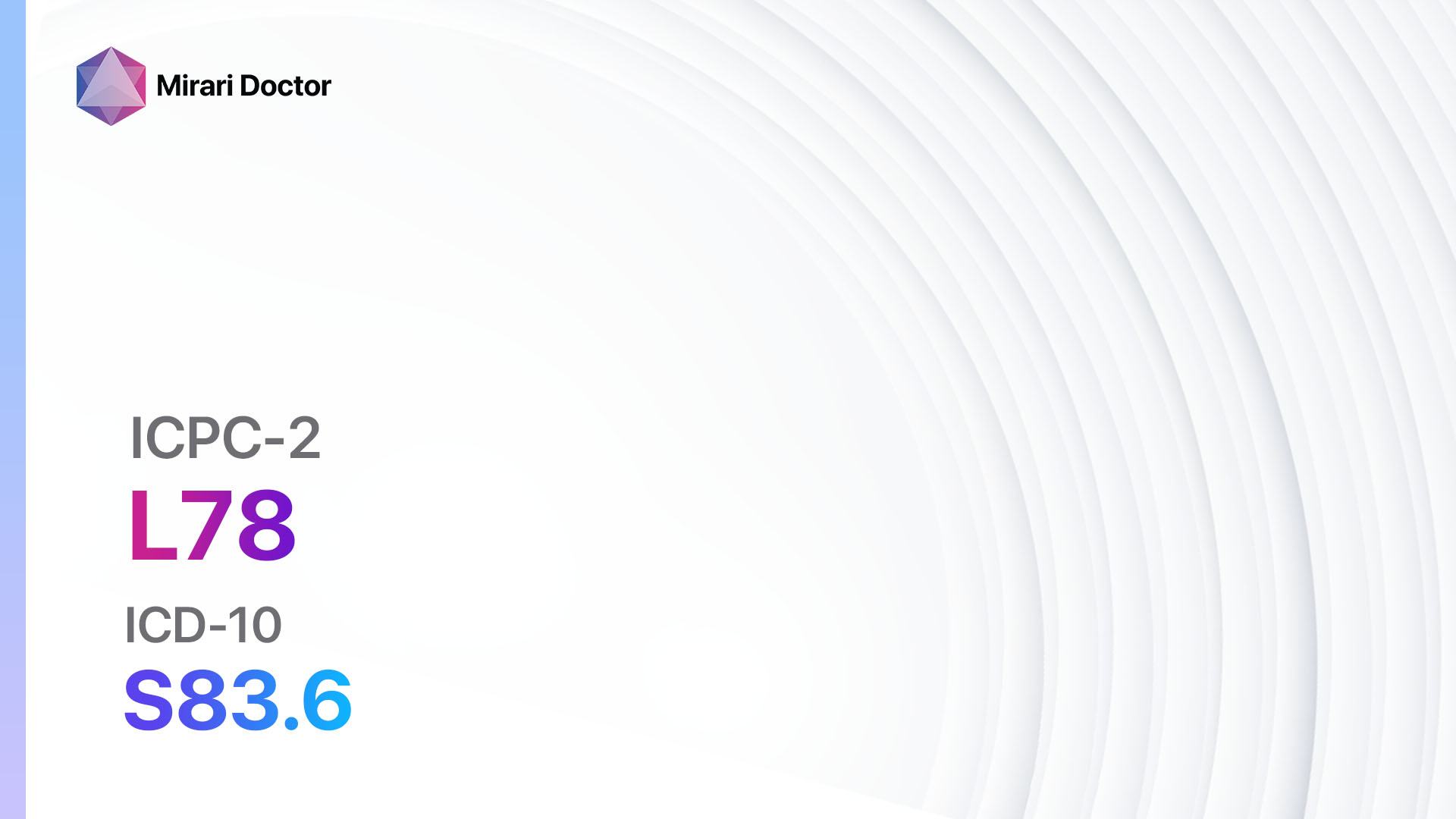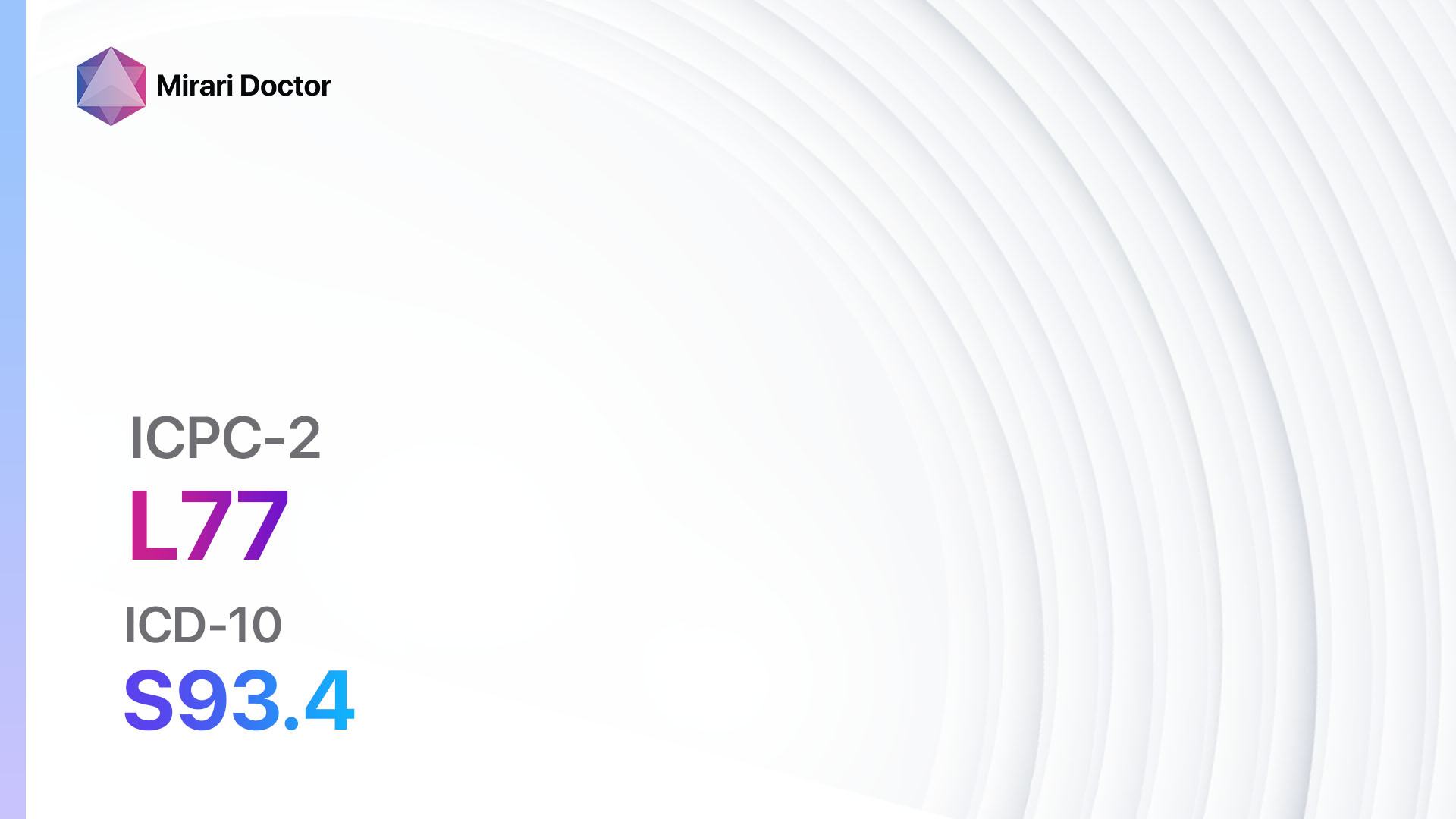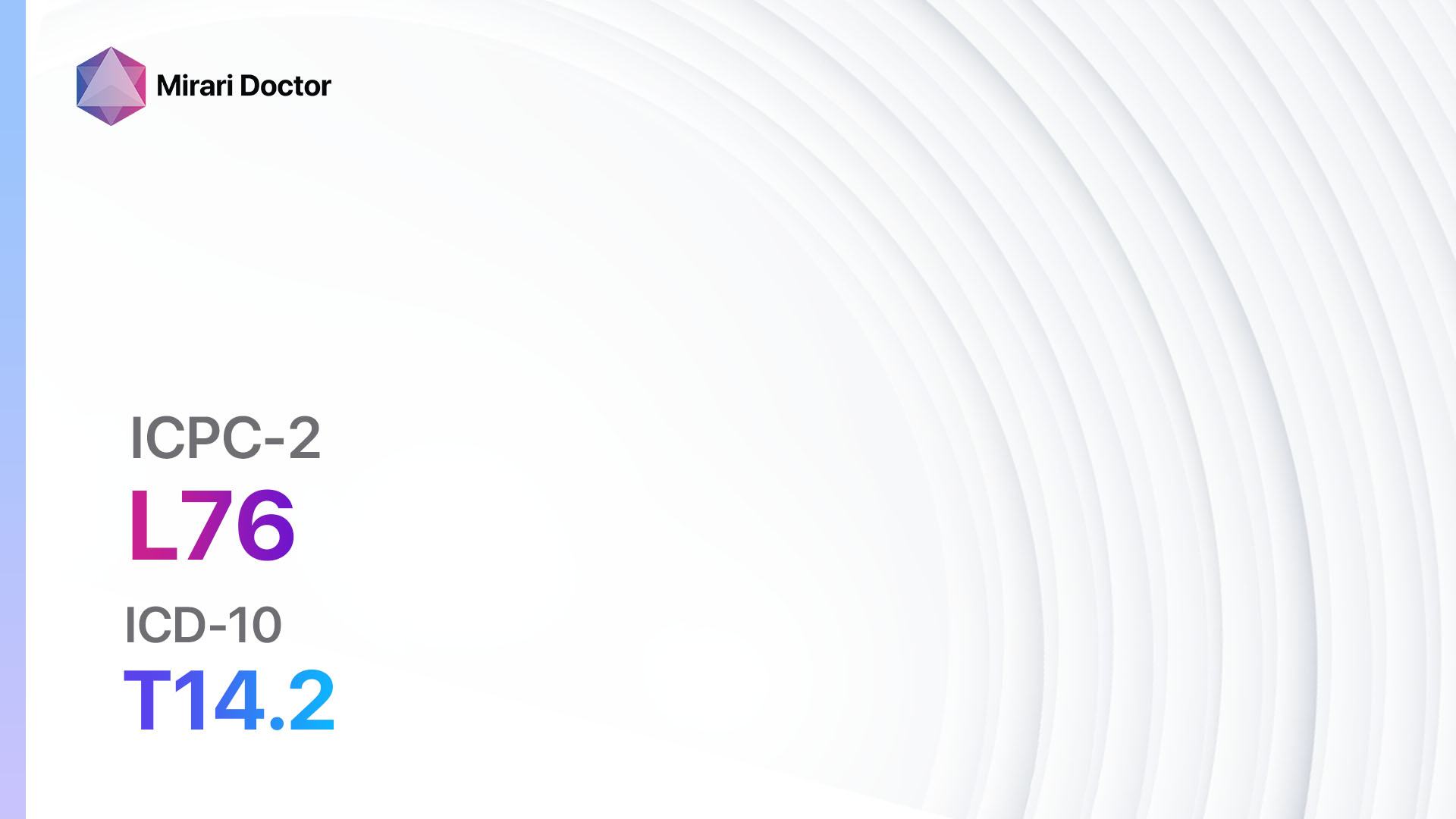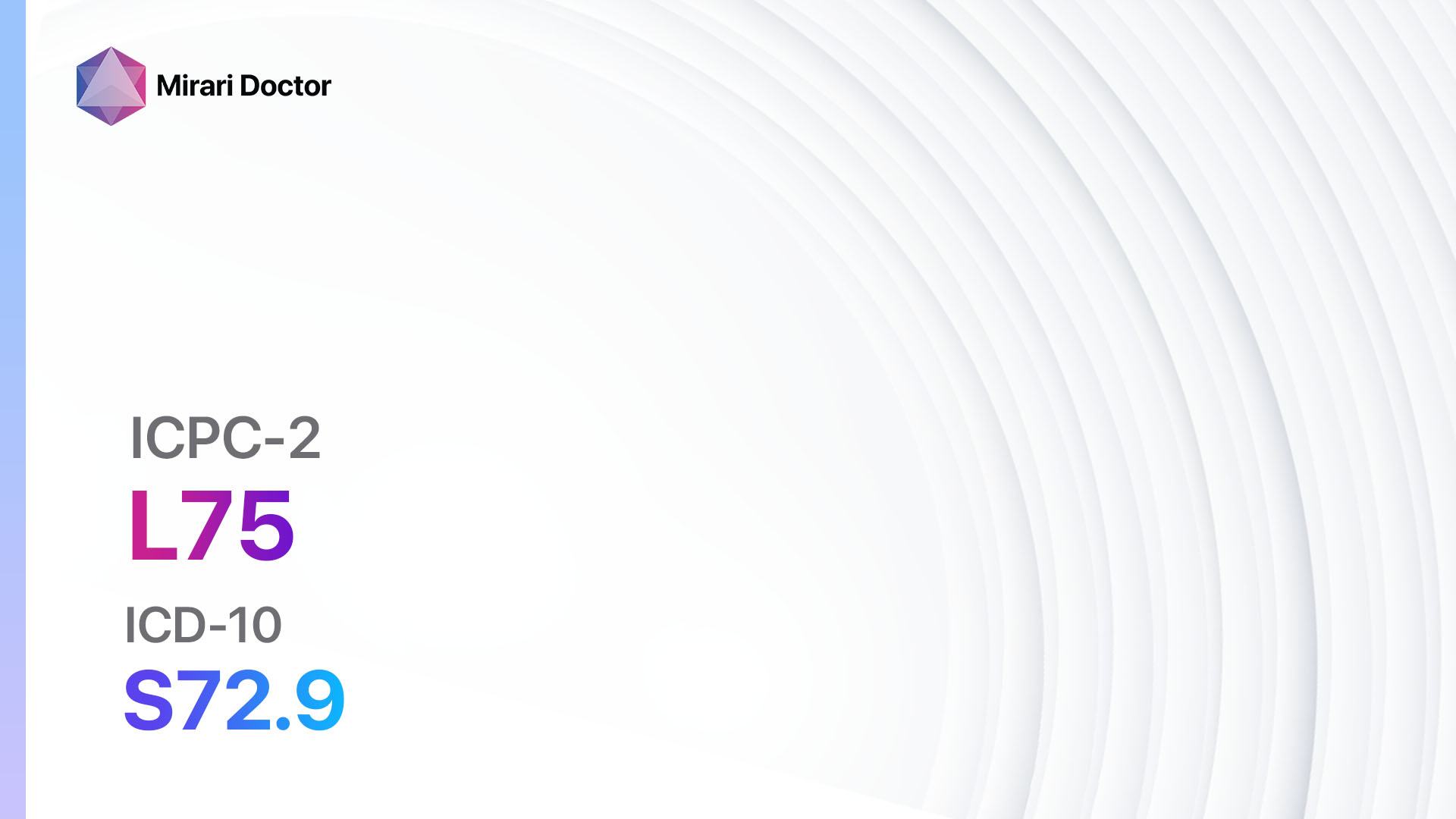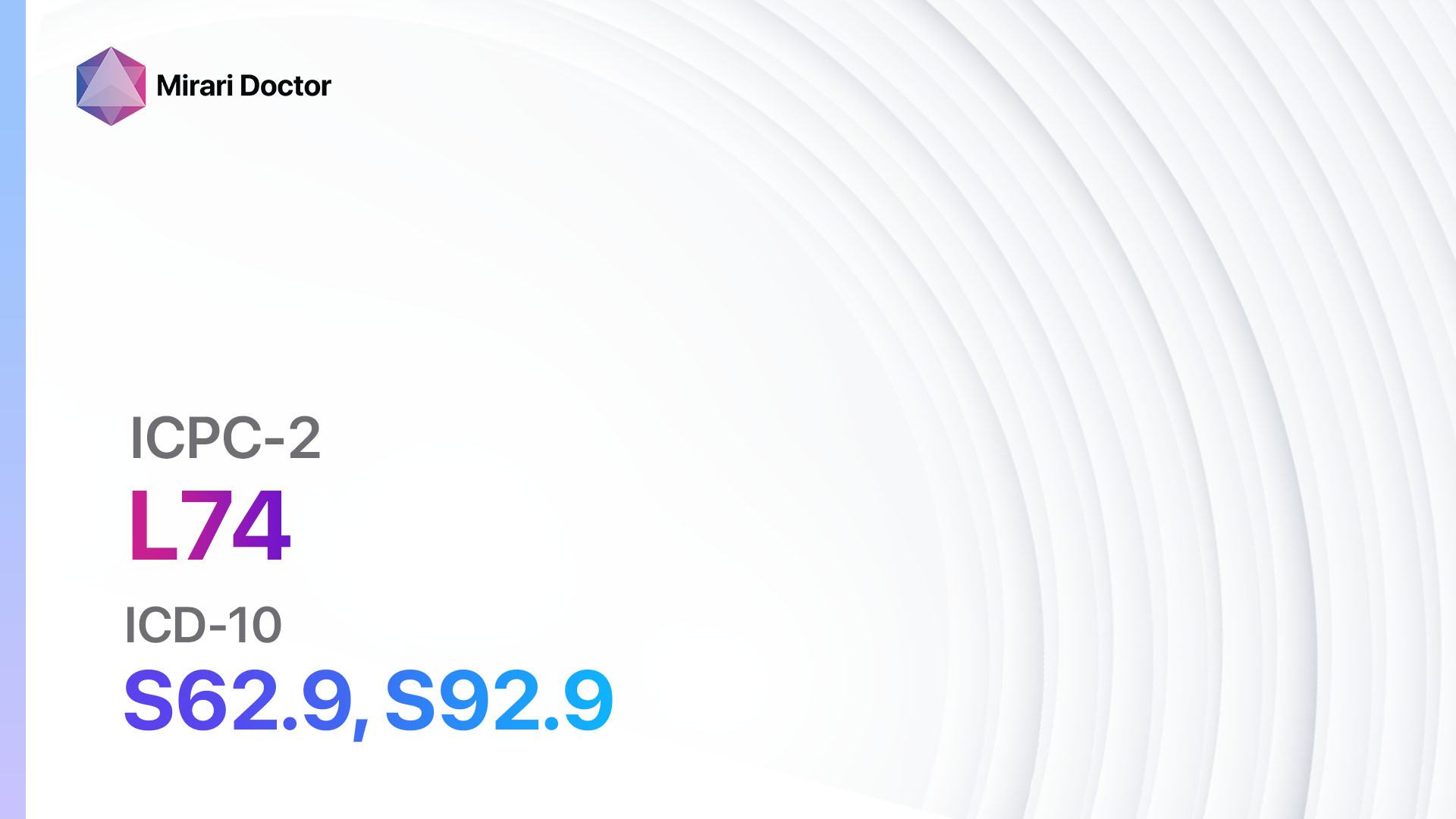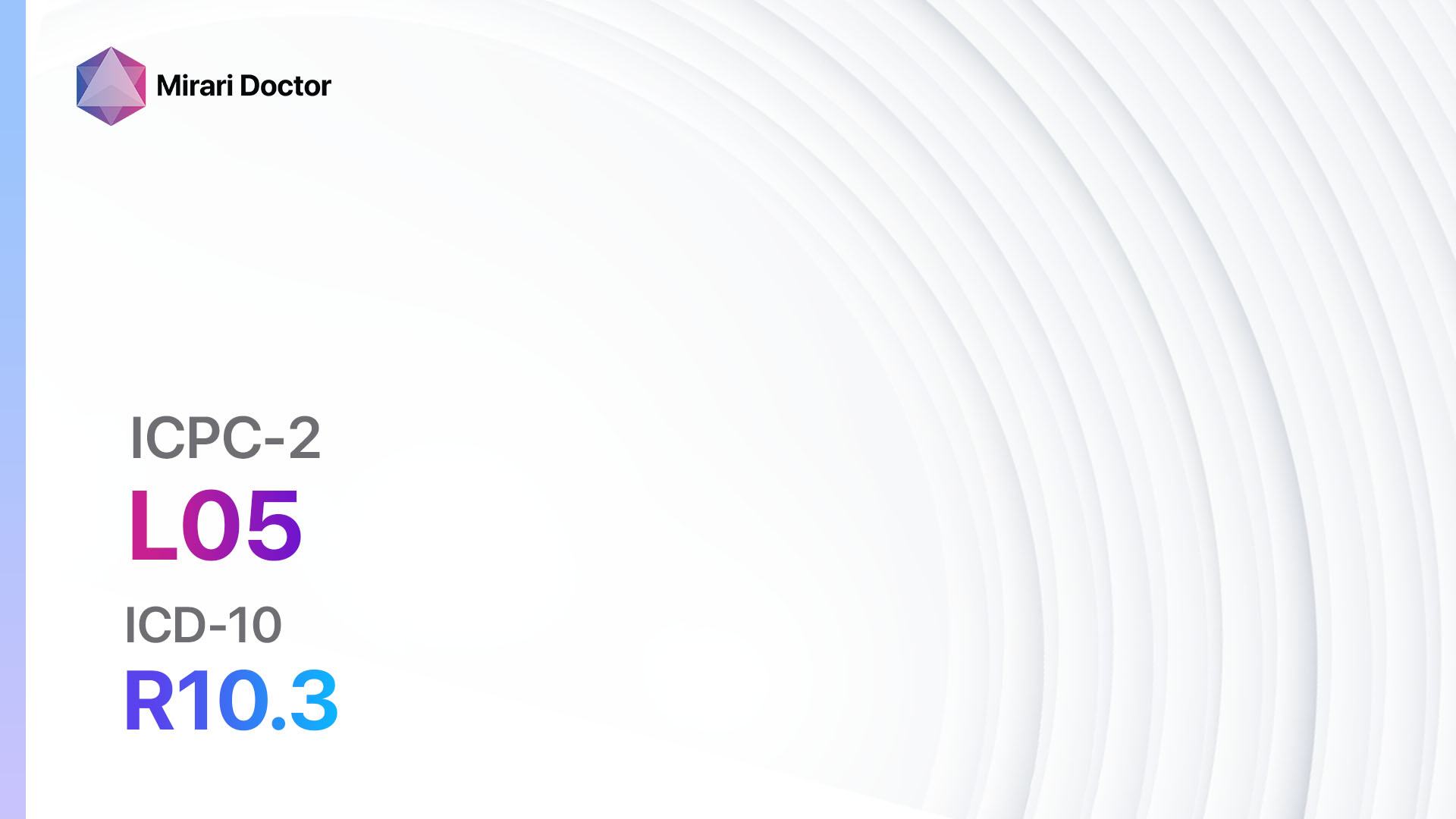
Introduction
Flank/axilla symptoms or complaints refer to any discomfort, pain, or abnormalities experienced in the flank or axilla regions of the body. These symptoms can be indicative of various underlying conditions, ranging from musculoskeletal issues to more serious medical conditions[1][2]. The aim of this guide is to provide a comprehensive overview of the symptoms, causes, diagnostic steps, possible interventions, and lifestyle interventions for flank/axilla symptom/complaint.
Codes
- ICPC-2 Code: L05 Flank/axilla symptom/complaint[3]
- ICD-10 Code: R10.3 Pain localized to other parts of lower abdomen[4]
Symptoms
- Flank pain: Dull, aching, or sharp pain in the flank region[5].
- Axillary swelling: Enlargement or swelling in the axillary region[6].
- Axillary pain: Discomfort or pain in the axillary region[6].
- Flank tenderness: Sensitivity or pain upon palpation of the flank area[5].
- Axillary lymphadenopathy: Enlarged lymph nodes in the axillary region[7].
- Flank mass: Presence of a lump or mass in the flank area[8].
Causes
- Musculoskeletal causes:
- Inflammatory causes:
- Systemic causes:
- Other causes:
Diagnostic Steps
Medical History
- Obtain a detailed medical history, including:
- Duration and characteristics of symptoms.
- Any recent injuries or trauma to the flank or axilla.
- History of kidney stones, urinary tract infections, or gallbladder issues.
- History of heart conditions or breast conditions.
- Any relevant family history.
- Any medications or treatments currently being taken.
Physical Examination
- Perform a thorough physical examination, including:
- Inspection of the flank and axilla regions for any visible abnormalities, swelling, or masses.
- Palpation of the flank area to assess for tenderness or presence of a mass.
- Palpation of the axillary lymph nodes for enlargement or tenderness.
- Range of motion testing of the shoulder and arm to assess for any musculoskeletal issues.
- Auscultation of the heart and lungs to rule out any cardiac or respiratory causes of referred pain.
Laboratory Tests
- Complete blood count (CBC) to assess for any signs of infection or inflammation.
- Urinalysis to check for the presence of blood or infection in case of suspected kidney stones or urinary tract infections.
- Liver function tests to evaluate liver health and rule out any liver-related causes of flank pain.
- Lipid profile to assess for any abnormalities in lipid levels that may contribute to cardiovascular causes of referred pain.
Diagnostic Imaging
- X-ray of the flank or axilla region to assess for any fractures, dislocations, or abnormalities in the bones.
- Ultrasound of the flank or axilla area to visualize the soft tissues, lymph nodes, and organs for any abnormalities or masses.
- CT scan or MRI of the abdomen or chest to obtain more detailed images of the organs and structures in the flank or axilla region.
- Mammogram or breast ultrasound in case of suspected breast-related causes of axillary symptoms.
Other Tests
- Electromyography (EMG) or nerve conduction studies (NCS) to assess for any nerve impingement or compression in the flank or axilla area.
- Biopsy of any suspicious masses or lymph nodes to rule out malignancy or determine the underlying cause.
- Genetic testing in case of suspected hereditary conditions or familial history of certain diseases.
Follow-up and Patient Education
- Schedule a follow-up appointment to review the results of the diagnostic tests and discuss further management options.
- Provide patient education regarding the importance of adhering to any prescribed treatments or interventions.
- Discuss lifestyle modifications and self-care measures that may help alleviate symptoms or prevent recurrence.
- Encourage regular follow-up visits to monitor progress and address any concerns or new symptoms.
Possible Interventions
Traditional Interventions
Medications:
Top 5 drugs for Flank/Axilla symptom/complaint:
- Nonsteroidal anti-inflammatory drugs (NSAIDs) (e.g., Ibuprofen, Naproxen):
- Cost: Generic versions can be $3-$20/month.
- Contraindications: Active peptic ulcer disease, history of gastrointestinal bleeding, severe renal impairment.
- Side effects: Upset stomach, heartburn, gastrointestinal bleeding.
- Severe side effects: Kidney damage, allergic reactions.
- Drug interactions: Anticoagulants, other NSAIDs, corticosteroids.
- Warning: Prolonged use may increase the risk of cardiovascular events.
- Muscle relaxants (e.g., Cyclobenzaprine, Methocarbamol):
- Cost: Generic versions can be $10-$30/month.
- Contraindications: Glaucoma, urinary retention, severe liver impairment.
- Side effects: Drowsiness, dizziness, dry mouth.
- Severe side effects: Seizures, allergic reactions.
- Drug interactions: Sedatives, alcohol, opioids.
- Warning: May cause drowsiness, avoid driving or operating heavy machinery.
- Antibiotics (e.g., Amoxicillin, Cephalexin):
- Cost: Generic versions can be $5-$30/month.
- Contraindications: Allergy to penicillin or cephalosporins.
- Side effects: Upset stomach, diarrhea, rash.
- Severe side effects: Severe allergic reactions, Clostridium difficile infection.
- Drug interactions: Oral contraceptives, warfarin.
- Warning: Finish the full course of antibiotics as prescribed.
- Analgesics (e.g., Acetaminophen, Tramadol):
- Cost: Generic versions can be $3-$20/month.
- Contraindications: Severe liver impairment, alcoholism.
- Side effects: Upset stomach, liver toxicity (with high doses of acetaminophen).
- Severe side effects: Liver failure (with high doses of acetaminophen), seizures (with tramadol).
- Drug interactions: Warfarin, alcohol, other opioids.
- Warning: Avoid exceeding the recommended dose of acetaminophen.
- Corticosteroids (e.g., Prednisone, Methylprednisolone):
- Cost: Generic versions can be $5-$30/month.
- Contraindications: Active infections, systemic fungal infections.
- Side effects: Increased appetite, weight gain, mood changes.
- Severe side effects: Adrenal suppression, osteoporosis.
- Drug interactions: Nonsteroidal anti-inflammatory drugs, anticoagulants.
- Warning: Taper the dose gradually when discontinuing long-term use.
Alternative Drugs:
- Topical analgesics (e.g., Lidocaine patches): Provide localized pain relief. Cost: $10-$50 per box.
- Antidepressants (e.g., Amitriptyline, Duloxetine): May help with neuropathic pain. Cost: $10-$50/month.
- Anticonvulsants (e.g., Gabapentin, Pregabalin): Can be effective for nerve-related pain. Cost: $10-$50/month.
- Topical NSAIDs (e.g., Diclofenac gel): Provide localized anti-inflammatory and analgesic effects. Cost: $10-$30 per tube.
- Antianxiety medications (e.g., Lorazepam, Alprazolam): May help with muscle tension and anxiety-related symptoms. Cost: $5-$30/month.
Surgical Procedures:
- Surgical intervention may be necessary in certain cases, such as:
- Removal of a tumor or mass in the flank or axilla region.
- Repair of a fractured rib or other musculoskeletal injuries.
- Lymph node biopsy or removal in case of suspected malignancy.
- The cost of surgical procedures can vary significantly depending on the specific procedure, hospital, and location. It is recommended to consult with a healthcare provider or surgeon for accurate cost estimates.
Alternative Interventions
- Acupuncture: May help alleviate pain and promote relaxation. Cost: $60-$120 per session.
- Chiropractic care: Manipulative therapy to address musculoskeletal issues. Cost: $50-$200 per session.
- Physical therapy: Exercises and manual techniques to improve strength and mobility. Cost: $50-$150 per session.
- Massage therapy: Manipulation of soft tissues to reduce pain and promote relaxation. Cost: $50-$150 per session.
- Herbal supplements: Some herbal remedies, such as turmeric or ginger, may have anti-inflammatory properties. Cost: Varies depending on the specific supplement.
Lifestyle Interventions
- Rest and ice: Resting the affected area and applying ice packs can help reduce inflammation and pain.
- Heat therapy: Applying heat to the flank or axilla region can help relax muscles and alleviate pain.
- Stretching and strengthening exercises: Specific exercises targeting the flank or axilla area can help improve flexibility and strength.
- Posture correction: Maintaining good posture can help prevent musculoskeletal issues and reduce strain on the flank and axilla regions.
- Weight management: Maintaining a healthy weight can reduce the strain on the musculoskeletal system and improve overall health.
- Stress management: Stress can contribute to muscle tension and exacerbate symptoms. Techniques such as meditation or deep breathing exercises can help manage stress levels.
- Avoidance of triggers: Identify and avoid any activities or movements that worsen symptoms.
- Physical activity modification: Modify or avoid activities that may aggravate symptoms, such as heavy lifting or repetitive motions.
It is important to note that the cost ranges provided are approximate and may vary depending on the location and availability of the interventions. It is recommended to consult with healthcare professionals or providers for accurate cost estimates and personalized treatment plans.
Mirari Cold Plasma Alternative Intervention
Understanding Mirari Cold Plasma
- Safe and Non-Invasive Treatment: Mirari Cold Plasma is a safe and non-invasive treatment option for various skin conditions. It does not require incisions, minimizing the risk of scarring, bleeding, or tissue damage.
- Efficient Extraction of Foreign Bodies: Mirari Cold Plasma facilitates the removal of foreign bodies from the skin by degrading and dissociating organic matter, allowing easier access and extraction.
- Pain Reduction and Comfort: Mirari Cold Plasma has a local analgesic effect, providing pain relief during the treatment, making it more comfortable for the patient.
- Reduced Risk of Infection: Mirari Cold Plasma has antimicrobial properties, effectively killing bacteria and reducing the risk of infection.
- Accelerated Healing and Minimal Scarring: Mirari Cold Plasma stimulates wound healing and tissue regeneration, reducing healing time and minimizing the formation of scars.
Mirari Cold Plasma Prescription
Video instructions for using Mirari Cold Plasma Device – L05 Flank/axilla symptom/complaint (ICD-10:R10.3)
| Mild | Moderate | Severe |
| Mode setting: 2 (Wound Healing) Location: 0 (Localized) Morning: 15 minutes, Evening: 15 minutes |
Mode setting: 2 (Wound Healing) Location: 0 (Localized) Morning: 30 minutes, Lunch: 30 minutes, Evening: 30 minutes |
Mode setting: 2 (Wound Healing) Location: 0 (Localized) Morning: 30 minutes, Lunch: 30 minutes, Evening: 30 minutes |
| Mode setting: 9 (Arthritis) Location: 0 (Localized) Morning: 15 minutes, Evening: 15 minutes |
Mode setting: 9 (Arthritis) Location: 0 (Localized) Morning: 30 minutes, Lunch: 30 minutes, Evening: 30 minutes |
Mode setting: 9 (Arthritis) Location: 0 (Localized) Morning: 30 minutes, Lunch: 30 minutes, Evening: 30 minutes |
| Mode setting: 7 (Immunotherapy) Location: 1 (Sacrum) Morning: 15 minutes, Evening: 15 minutes |
Mode setting: 7 (Immunotherapy) Location: 1 (Sacrum) Morning: 30 minutes, Lunch: 30 minutes, Evening: 30 minutes |
Mode setting: 7 (Immunotherapy) Location: 1 (Sacrum) Morning: 30 minutes, Lunch: 30 minutes, Evening: 30 minutes |
| Total Morning: 45 minutes approx. $7.50 USD, Evening: 45 minutes approx. $7.50 USD |
Total Morning: 90 minutes approx. $15 USD, Lunch: 90 minutes approx. $15 USD, Evening: 90 minutes approx. $15 USD, |
Total Morning: 90 minutes approx. $15 USD, Lunch: 90 minutes approx. $15 USD, Evening: 90 minutes approx. $15 USD, |
| Usual treatment for 7-60 days approx. $105 USD – $900 USD | Usual treatment for 6-8 weeks approx. $1,890 USD – $2,520 USD |
Usual treatment for 3-6 months approx. $4,050 USD – $8,100 USD
|
 |
|
Use the Mirari Cold Plasma device to treat Flank/axilla symptom/complaint effectively.
WARNING: MIRARI COLD PLASMA IS DESIGNED FOR THE HUMAN BODY WITHOUT ANY ARTIFICIAL OR THIRD PARTY PRODUCTS. USE OF OTHER PRODUCTS IN COMBINATION WITH MIRARI COLD PLASMA MAY CAUSE UNPREDICTABLE EFFECTS, HARM OR INJURY. PLEASE CONSULT A MEDICAL PROFESSIONAL BEFORE COMBINING ANY OTHER PRODUCTS WITH USE OF MIRARI.
Step 1: Cleanse the Skin
- Start by cleaning the affected area of the skin with a gentle cleanser or mild soap and water. Gently pat the area dry with a clean towel.
Step 2: Prepare the Mirari Cold Plasma device
- Ensure that the Mirari Cold Plasma device is fully charged or has fresh batteries as per the manufacturer’s instructions. Make sure the device is clean and in good working condition.
- Switch on the Mirari device using the power button or by following the specific instructions provided with the device.
- Some Mirari devices may have adjustable settings for intensity or treatment duration. Follow the manufacturer’s instructions to select the appropriate settings based on your needs and the recommended guidelines.
Step 3: Apply the Device
- Place the Mirari device in direct contact with the affected area of the skin. Gently glide or hold the device over the skin surface, ensuring even coverage of the area experiencing.
- Slowly move the Mirari device in a circular motion or follow a specific pattern as indicated in the user manual. This helps ensure thorough treatment coverage.
Step 4: Monitor and Assess:
- Keep track of your progress and evaluate the effectiveness of the Mirari device in managing your Flank/axilla symptom/complaint. If you have any concerns or notice any adverse reactions, consult with your health care professional.
Note
This guide is for informational purposes only and should not replace the advice of a medical professional. Always consult with your healthcare provider or a qualified medical professional for personal advice, diagnosis, or treatment. Do not solely rely on the information presented here for decisions about your health. Use of this information is at your own risk. The authors of this guide, nor any associated entities or platforms, are not responsible for any potential adverse effects or outcomes based on the content.
Mirari Cold Plasma System Disclaimer
- Purpose: The Mirari Cold Plasma System is a Class 2 medical device designed for use by trained healthcare professionals. It is registered for use in Thailand and Vietnam. It is not intended for use outside of these locations.
- Informational Use: The content and information provided with the device are for educational and informational purposes only. They are not a substitute for professional medical advice or care.
- Variable Outcomes: While the device is approved for specific uses, individual outcomes can differ. We do not assert or guarantee specific medical outcomes.
- Consultation: Prior to utilizing the device or making decisions based on its content, it is essential to consult with a Certified Mirari Tele-Therapist and your medical healthcare provider regarding specific protocols.
- Liability: By using this device, users are acknowledging and accepting all potential risks. Neither the manufacturer nor the distributor will be held accountable for any adverse reactions, injuries, or damages stemming from its use.
- Geographical Availability: This device has received approval for designated purposes by the Thai and Vietnam FDA. As of now, outside of Thailand and Vietnam, the Mirari Cold Plasma System is not available for purchase or use.
References
- Klyne DM, Barbe MF, James G, Hodges PW. Does the Interaction between Local and Systemic Inflammation Provide a Link from Psychology and Lifestyle to Tissue Health in Musculoskeletal Conditions? Int J Mol Sci. 2021;22(14):7299. doi:10.3390/ijms22147299
- Ursini F, Naty S, Grembiale RD. Musculoskeletal and Rheumatic Diseases Induced by Immune Checkpoint Inhibitors: A Review of the Literature. Curr Drug Saf. 2018;13(3):150-164. doi:10.2174/1574886313666180508122332
- Rosendal M, Carlsen AH, Rask MT, Moth G. Symptoms as the main problem in primary care: A cross-sectional study of frequency and characteristics. Scand J Prim Health Care. 2015;33(2):91-99. doi:10.3109/02813432.2015.1030166
- ICD-10 Code: R10.3 Pain localized to other parts of lower abdomen. ICD10data.com. Accessed June 21, 2024. https://www.icd10data.com/ICD10CM/Codes/R00-R99/R10-R19/R10-/R10.3
- Flank Pain: Causes, Symptoms, and Diagnosis. Healthline. Accessed June 21, 2024. https://www.healthline.com/health/flank-pain
- Axillary Lymphadenopathy: Symptoms, Causes, Diagnosis, Treatment. Healthline. Accessed June 21, 2024. https://www.healthline.com/health/cancer/axillary-lymphadenopathy
- Pietrzak M. Adhesive capsulitis: An age related symptom of metabolic syndrome and chronic low-grade inflammation? Med Hypotheses. 2016;88:12-17. doi:10.1016/j.mehy.2016.01.002
- Ali AA, Bilgrami Z. A woman with flank pain and swelling. JACEP Open. 2022;3(6):e12809. doi:10.1002/emp2.12809
- Paininmotion.be. The role of systemic inflammation in chronic musculoskeletal conditions. Accessed June 21, 2024. https://paininmotion.be/blog/detail/role-systemic-inflammation-chronic-musculoskeletal-conditions
- Stahnke K, Morawietz L, Moroder P, Scheibel M. Synovitis as a concomitant disease in shoulder pathologies. Arch Orthop Trauma Surg. 2019;139(8):1111-1116. doi:10.1007/s00402-019-03180-0
Related articles
Made in USA



